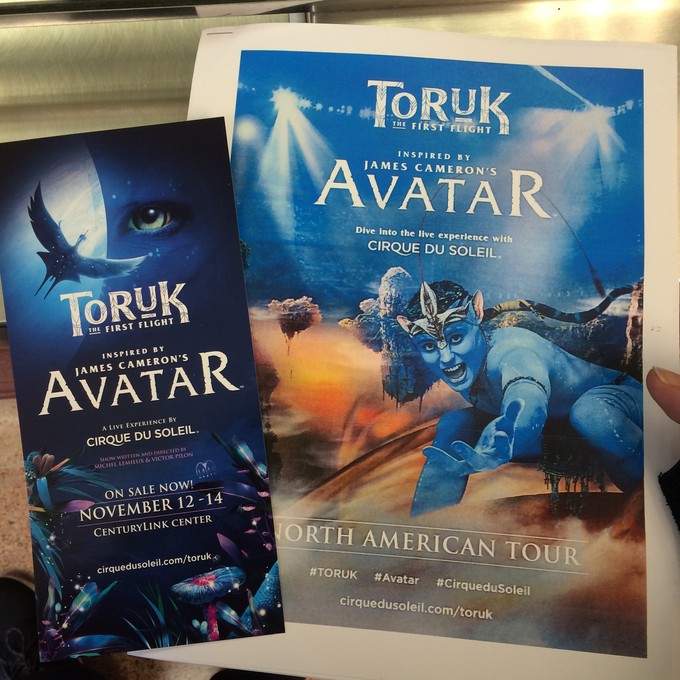
The first cool thing about this presentation for TORUK, the AVATAR-inspired Cirque du Soileil that’s set to open in a few weeks, was that they got my name right.
I mean, maybe I shouldn’t have been surprised. Though the company’s various shows tour constantly, basically peppering the American landscape, it remains at heart, thoroughly French-Canadian. Perhaps that is why they never really tried tackling a film before, though they’ve already based shows around iconic acts such as The Beatles and Michael Jackson; it remains a relatively high-minded institution, and the bulk of American films (arguably the only ones with the scope and international cachet to be worth the Cirque treatment) don’t really have the kind of artistic depth to warrant this kind of pseudo avant-garde interpretation.
But that’s the thing about AVATAR. Not only is it the most successful movie ever made by over half a billion dollars, not only is it arguably the most widely-known original property of the past decade, but its also dealing with fairly liberal, high-minded ideas at its center. Sure, the movie can be a little clunky (to put it mildly) in its presentation of an indigenous culture being threatened by capitalistic foreign invaders, and reductive in its Hindu/Native-American/Gaia Theory spirituality, but the fundamental message(s) at the films heart is something that, as I’ve learned, is absolutely worth expanding on and looking at in a different context than Cameron’s original film.
As the show’s directors, Michel Lemieux and Victor Pilon, explained to us in their introduction, TORUK, which will debut in Bossier City, LA before taking the act on the road for a multi-year tour, takes place hundreds of years before the events of AVATAR, long before the first human stepped foot on Pandora. The story revolves around three young Na’vi who team up to try and unite the various clans of the planet in an effort to keep a supervolcano from destroying the precious Hometree. The directors took the time to mention that, aside from the usual acrobatics and special effects, there would be the closest thing to a straightforward narrative in a Cirque du Soleil production thus far; there are intimate dialogue scenes (all in Na’vi, of course), with a narrator speaking in English (another first for Cirque). The directing duo have worked on numerous productions with the company, and Lemiux mentioned that his and Pilon’s motto has always been “evoke, invoke, and provoke,”; they decided to work with Cameron and Lightstorm when they were approached specifically because they saw the potential to do those things with their source material. Based on what I saw, I’d say they might’ve actually succeeded in depicting a real-life, CGI-free Pandora that gets the message of Cameron’s film across in a different, ostensibly superior way.
After the intro, we were shown roughly half an hour from the second act of TORUK, which we were told was all action-packed, and had none of the “more intimate scenes” that will take place in the first half. Sure enough, the segment we saw was essentially two long action scenes. The first was an attack on the three protagonists by viperwolves, those pesky green-eyed, six-legged carnivores that almost ate Jake Sully in the film. The viperwolves are puppets, operated by a lone puppeteer, lined with LED lights along their scales and with eyes that glow in the dark. A rival clan enters the scene, and surrounds our heroes, allowing one of them to fell one of the beasts, leading to my favorite moment in the whole presentation: one of the leads mercifully and somberly knifes the downed creature, whose corpse is then carried out by the clan in a ceremonial, melancholy fashion. It evoked (there’s that word) that tradition, commonly associated with Native American cultures, of taking the time to honor the animals killed for food or leather or what have you. Told in this quiet, elegiac manner, without any explanations (remember, this is ages before the Great Sorrow, or the invasion of Pandora by humans), it had far more impact than any of the traditions explained in the movie’s clunky script, and was indicative of how, oddly enough, this stage production appears to get Cameron’s message across better than he did with 12+ years of development and hundreds of millions of dollars.
There was a stunning transition between this scene and the next: an overhead projection over the whole stage moved as the background of the set shifted, revealing the Hometree and its interior, where the narrator is perched. His name is “The Storyteller”: he’s the ornately dressed Lawgiver-in-BATTLE-FOR-THE-PLANET-OF-THE-APES character, telling us the story from hundreds of years in the future, and the press notes intimated that he has had some sort of relationship with Sigourney Weaver’s Dr. Grace Augustine, so he’d be alive at the time of Jake Sully’s revolution (though nothing we saw of the actual production hinted at this). As the projection shifted across the stage, it created the illusion of our characters moving from location to location even though they were essentially walking in place (it works better in execution than it sounds). It is hard to express how expansive and immersive the production is. The stage is ostensibly a circle around the center of the arena that serves as a sort of border between the show and the audience, with a center set that constantly, invisibly changes. There isn’t a stone, a floating mountain, a rope bridge, or even solid earth that isn’t completely seamless, occasionally appearing and disappearing mid-scene as the performers (referred to as artists) climb and traverse them with acrobatic aplomb.
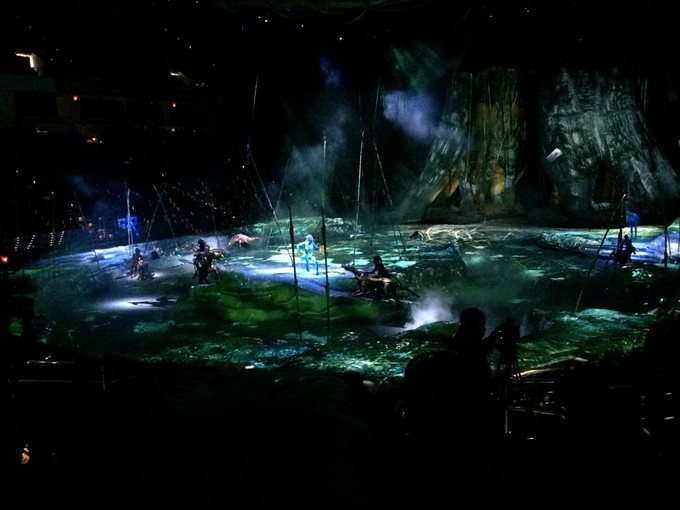
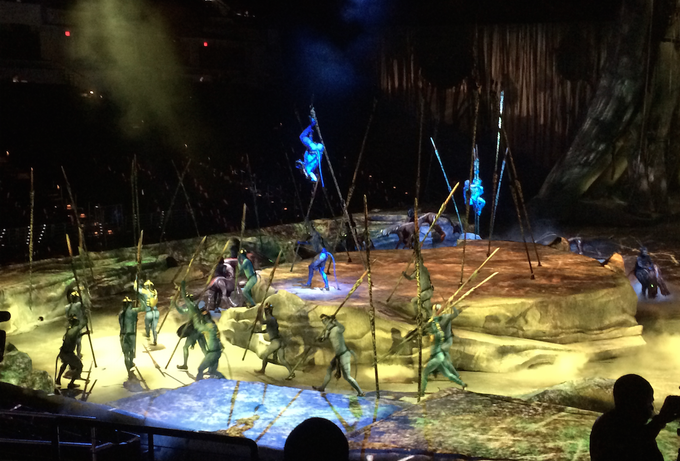
The second major set piece was a sequence featuring a number of creatures, including Direhorses (horse-looking things, portrayed by two black-clad puppeteers running in tandem underneath the puppet) and the titular Toruk, the flaming red flying creature that also played a crucial part in the movie. The idea here, like then, is that the clans will only unite under the leadership of the Toruk Makto, a Na’vi that can actually ride the beast, and our three heroes are trying to jump on and wrangle one of those things like a wild horse. For the Toruk itself, they use a 1:2 scale marionette with a 40-foot wingspan operated by six puppeteers on the ground.There are a bunch of flying creatures called "banshees" on display, which are essentially small kites. For the Toruk effects, the show brought in kite specialists, another first for Cirque du Soliel. At one point, a rope bridge manifests itself in the middle of the stage, and the protagonists climb and tumble on it with their full weight like it’s a fixed object. In one moment, another rival clan surrounds the three heroes in the center as they mount oversized poles, looking down at the helpless, imprisoned characters:
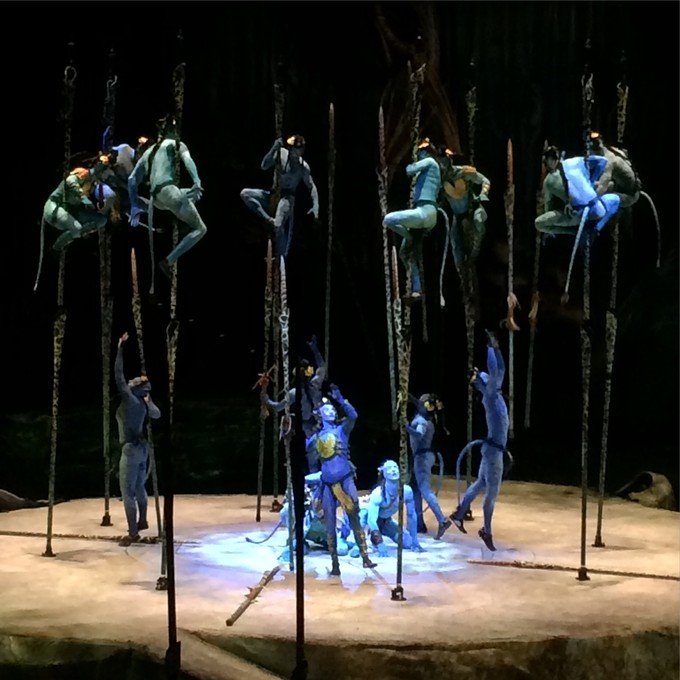
While I was dazzled by the athleticism, creativity, and sheer craft commonly associated with Cirque du Soleil, what I was most struck by was how more charmed I was by this world than I was when I watched the film. Without requiring explanations of the Na’vi or their cultures, the presence of human characters, or even English dialogue, the world of Pandora somehow seems more fully fleshed-out, less hokey, more real. Here, it and its inhabitants are not things we are hearing characters refer to as important, meaningful, and worth fighting for; we see them as they are, on their own terms, rather than what poorly-written humans think of them, and we’re allowed to judge them accordingly. After years of blowing off this mythology the same way Giovanni Ribisi’s character did in the movie, the snippet I saw here was the thing that finally convinced me, “Hmm, maybe there is something to this,” which is maybe the biggest compliment I can give Lemieux, Pilon, and the rest of the creative team.
After the presentation, we were split up into groups, and rotated around various departments to hear from them individually. First, we sat with Lemieux and Pilon in the arena itself. The two have worked together for 25 years, and have their press personas down solid; Lemieux is more showman-y, boisterous and smiley, while Pilon seems more laid-back and down-to-earth, taking the time to shake everyone’s hand after the chat was officially over. They mentioned that, even though they’ve worked with Cirque a handful of times over the years, this production was a particular challenge; aside from having to live up to the world that was depicted in one of the most expensive AND the second most widely-seen movie of all time, they had to contend with a shorter prep time, a smaller stage (Bossier’s CenturyLink Center), and a smaller cast than they’d ever been provided for a Cirque show before. Plus, they obviously wanted to push boundaries and play with techniques and technology that haven’t been tried before, which added more logistical challenges.
We then moved on to speak with Bernard Fouche, who was in charge of the TORUK app. My immediate reaction was, of course, “Oh yeah, an app to promote the show. Super cool.” But what Fouche demonstrated, via a concise, well-designed Powerpoint, was something that would actually be integrated into the show itself. Basically, when you buy a ticket, you get access to the app, which first asks you what city you’re seeing it in, the date of the show, and even your row and seat number. Then, during the show, it will notify you (provided you allow it access to your notifications) when it is time to break out your phone, and you will use it to participate in a number of scenes during the actual production. For example, there’s a scene where green firefly-looking creatures appear to fly around the auditorium, and if your phone is buzzed, you’ll be prompted to stick your screen up, and the animations will play across the various phones in the audience. Another cool thing is that this won’t be a uniform experience; where you are sitting will have a direct impact on what you will be called upon to participate in, so that everyone in the house has a unique interaction with the show. This banks a lot on the audience’s willingness to both download the app and to be cognizant of their phones during the actual show (something which Lemieux had specifically lamented not 15 minutes prior to this presentation), but if they pull it off, it’ll certainly be something unlike anything I’ve ever seen at a live show, as well as being an interesting way of tackling the troubling issue of cell phone ubiquity.
Next, we left the arena and walked through the surrounding halls, where we saw a few of the artists flexing, stretching, and relaxing in one of the makeshift practice rooms scattered throughout the building. We were led to Jon Landau, Lightstorm Entertainment COO and producer of both AVATAR and TITANIC, and Neilson Vignola, “Director of Creation” for TORUK and a Cirque collaborator for almost 20 years, who casually sat on couches and proudly talked about the production. They boasted about the show using kite specialists for the first time in a Cirque production, as well as the heavy emphasis on puppeteering (of the 35 performers, 6 are solely puppeteers). Someone asked about the trick of adapting the late James Horner’s music for the show, and they mentioned their composers, “Bob and Bill” (actually Guy Dubuc an Marc Lessard, also responsible for numerous Cirque shows and, oddly enough, the soundtrack to SPLINTER CELL: PANDORA TOMORROW), handled the task gloriously; based on what I’d heard, I’d be hard-pressed to disagree (if that goofy chanting and wailing of the film score popped up on the soundtrack, I sure didn’t notice).
Several of the members of my group were AVATAR “superfans” (I heard them described this way repeatedly by numerous people) who not only had already met Landau at other events, but were experts in the Na’vi language. Like most fake languages, it was built (by Paul Frommer) around certain words and expressions, rather than a specific syntax, but the language experts said that in the years since AVATAR’s release, Na’vi has developed into something more closely approximating a real language. Sure enough, Landau and Vignola claimed that getting the language right was a big part of the production, and that they worked closely with Frommer to ensure that, “Even if you don’t know what they’re saying, you know what they’re saying.”
I asked about what the Toruk meant to them, and why they felt it necessary to build the first all-new AVATAR story since the film around the same “Toruk Makto” myth that was so prominent in the film. They both agreed that using the Toruk again was due to the sheer difficulty of connecting a story that takes place long before any of the film’s characters have been born with the source material that everyone knew and loved; the beast was not only mythical, beautiful, and elegant in a way that would transcend a specific time period in Pandora history, but was also something elusive, something that didn’t have the kind of rock-solid, expressive personality of, let’s say, Wes Studi’s chief Eytukan. As to what the metaphor of the Toruk represented to them, they each had a different answer. To Vignola, the Toruk represents the small working with the big for a common goal; the Na’vi and the Toruk are at odds in many ways, including their disproportionate size, but will unify when both are threatened, such as when the Hometree is in danger. Landau simply said that he thinks of it as a metaphor for overcoming life’s challenges, or grabbing the bull by the horns in an almost literal fashion.
Three other choice tidbits from these guys. First, that the show will run for several years (hilariously, their statement “it’ll run for years” was misinterpreted by one of the group members as “it’ll run FOUR years,” and she kept mentioning the four-year run in her questions long after she’d been corrected). Second, that several new creatures were designed specifically for the show, with Lightstorm's complete supervision and approval. Landau also hinted fairly heavily that there was a strong chance at least one of these new creatures could find its way into the sequels. Considering they got three movies and at least 7.5 hours of screentime to fill, why wouldn’t they utilize creature designs that already exist and are officially canon? The last little piece of info: the AVATAR-Land they’re constructing in Disneyworld is officially called Pandora. Obvious I suppose, but the person asking about it was caught calling it “Avatar-Land,” so here it is.
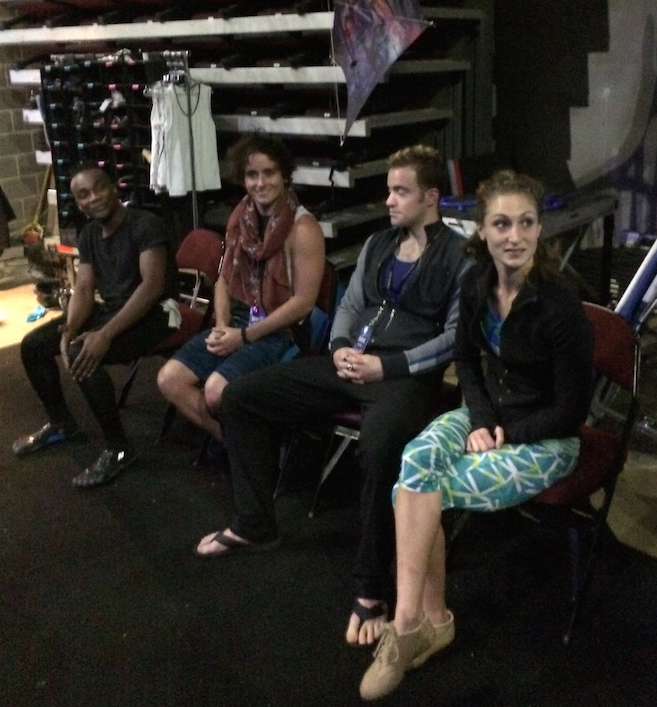
Unfortunately, we had to move on before I had a time to grind things to a halt with my questions about DICK TRACY (which Landau co-produced). The next group we talked to were several of the performers, who, again, are referred almost exclusively as “artists.” The ones we met were Jeremiah Hughes, Zoe Sabattie, Daniel “Crispy” Crisp, and Daudet Grazai. The show is structured such that different actors portray different characters at various points in the story, so that the female lead of one set-piece might be a different artist than the one who played same character in a different scene. These four all rotated in for one of the central three characters, and as they mentioned, they all came from different backgrounds. The Australian-born Crispy comes from a martial arts/surfing background, Hughes was an all-American dancer, the French-accented Sabattie has a circus history (specifically trapeze and rope work), and Grazai is a more avant-garde experimental dancer.
Someone asked “Have you guys broken any bones?” and one of them (won’t say who) replied, “Officially? None.” He/she explained that it would be impossible to get insured for a Cirque show with too many broken bones on record, but that it’s inevitable when doing what these guys do on a regular basis. Based on what we saw, whatever they’ve gone through in the past has slowed them down not a hitch.
One huge challenge for the artists was getting the Na’vi dialect right, seeing as there’s a fair amount of dialogue in the language, and they worked closely with Paul Frommer, as well Neytiri’s body double from the film production, to make sure that they sounded right. Hughes seemed the most fluent, and could even string sentences together, to the delight of the language experts in our group. It’s weird to think about these performers as real people sometimes. The stunts they do are so elaborate, so death-defying and breath-taking, that they sometimes seem otherworldly, like Adonises or demigods, but these guys just seemed humble, energetic, and super-thankful to be working on this show. It sounded like they all had ambitions to work with Cirque du Soleil one day, and I perhaps should’ve realized before that they are the benchmark for high-level performing of this sort around the globe.
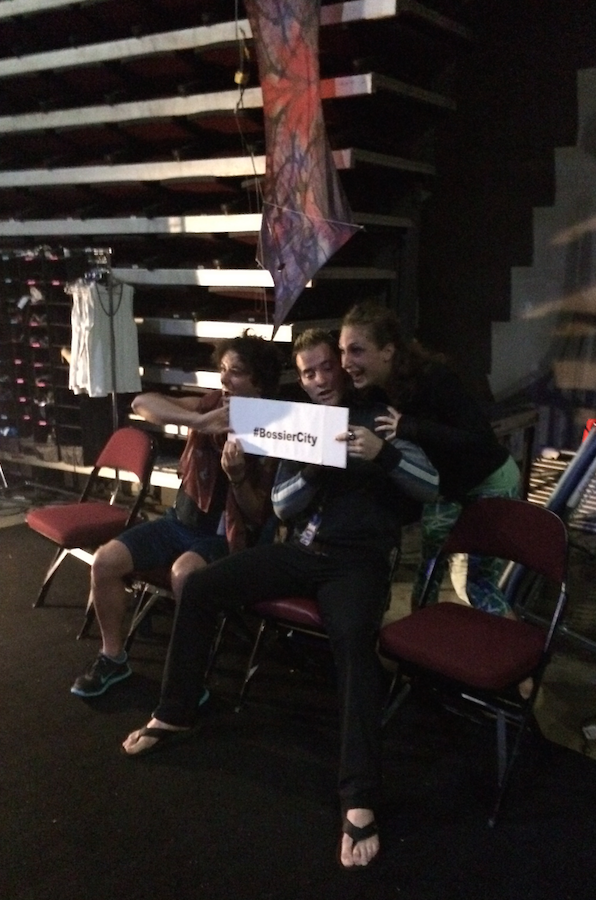
Next was the head of the puppet department, Patrick Martel. We chatted next to two models of the viperwolves, one of which had blue and red LED rights running along its scales. The coolest part of this section was watching Martel actually operate one of the viperwolves to show us how they functioned on stage. One of my group members filmed this and posted it on Instagram (as well as moments from the show itself, if you check out the account), which you can see here, along with my picture of the stationary puppets:
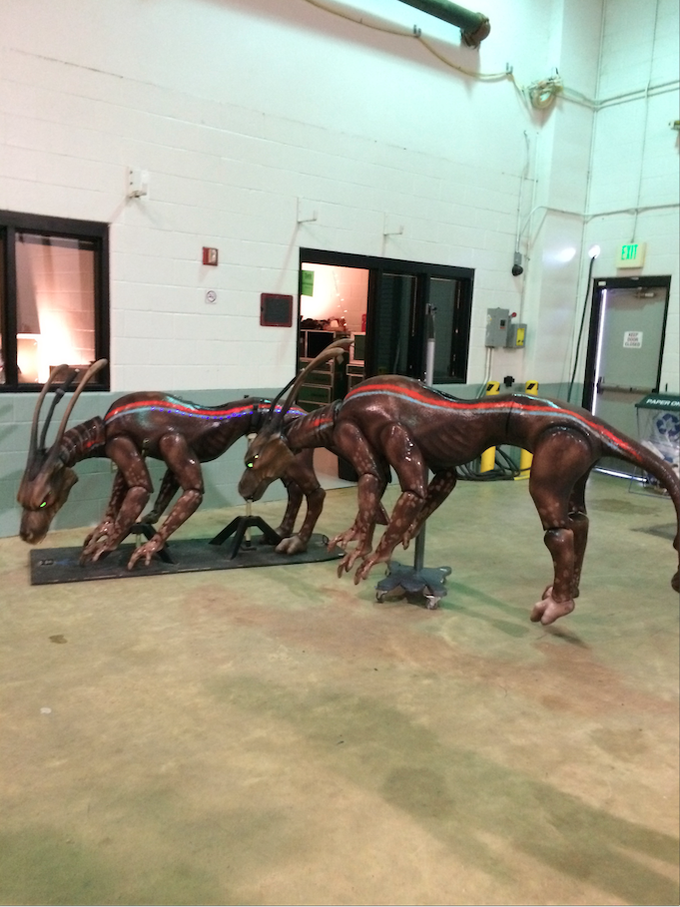
Though the puppeteers are clad in black, you can still see them and are aware of their presence like in the stage production of THE LION KING. I asked about the balance between expressionism and realism in these performances, and Martel said they got around it by thinking of the puppeteers as “the spirit of Eywa” (the “god” of Pandora). Which kind of makes sense; they’re like the invisible hand of god controlling the behavior and movements of these creatures, and it’s cool to think that they’ve incorporated the audience noticing these performers into the actual narrative of the production. Plus, as Martel also mentioned, it helps you appreciate the tactile, grueling work on display without blowing their efforts off as inscrutable special effects trickery.
The best question (which I wish I’d asked) was about what materials the puppets were made of. They were crafted out of carbon fiber and plastazote foam, which looks a bit like hard plastic up close but is soft to the touch and shockingly lightweight without being flimsy. They also used LED lights for the green, glowing eyes and the aforementioned blue and red scales. I wish we’d got to seen more of their work up close, as this is an aspect of Cirque du Soleil which seems rather new and brave, but up to the standards of the rest of the departments.
Our last stop on this tour was the costume department, headed by a true legend, costume designer Kym Barrett. You may not know the name, but you know both her work and the countless costumes she’s influenced: aside from being the Wachowskis’ go-to designer (on everything they’ve directed from THE MATRIX through JUPITER ASCENDING) she’s also worked on ROMEO + JULIET, THREE KINGS, FROM HELL, and recently, the first AMAZING SPIDER-MAN. I got a little sheepish in the presence of the person who conjured up those iconic, still-super-badass leather getups from the first MATRIX and the brilliant, time-transcending costumes in CLOUD ATLAS, but the Australian-accented Barrett was surprisingly the most inviting of all the interview subjects, turning off the lights and interrupting the work of her collaborators in the room to show off the bio-luminescent Na’vi costumes (I also was lucky to get a one-on-one interview with her, which I’ll post later in the week).
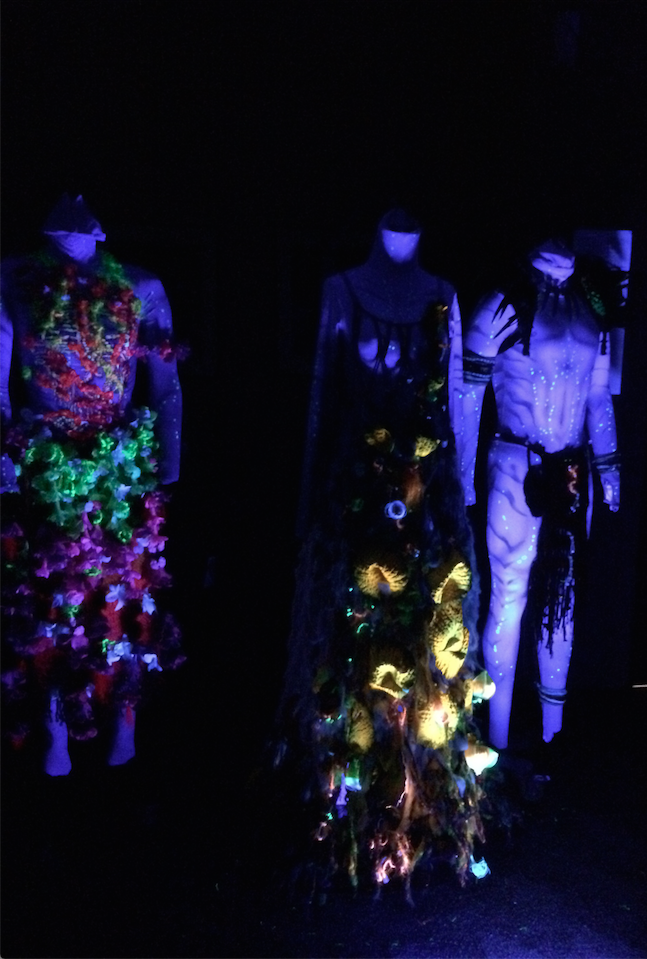
The costumes were tricky; not only did Barrett have to work on the pre-existing designs by Mayes C. Rubeo and Deborah Lynn Scott, but she had to evoke the size, movement, and color of the Na’vi without the use of the CGI that depicted them in the film. One thing she did was raise the placement of the nipples and the belly button on the torso in an attempt to create the illusion of height, seeing as none of the performers are actually 10-feet tall. Another hurdle was the Na’vi’s elaborate hairdos, not to mention those pesky ponytails, and making them light enough so that the performers’ mobility wouldn’t be an issue. Ms. Barrett let us lift up the headpieces ourselves, and it really was surprising how little they weighed, considering how dense and intricately designed they appeared to be on the surface.
Another nifty trick was to apply different shades of color to the various clans we encounter in the story. Moreso than in AVATAR, we see a large swath of the cultures living on the massive moon of Pandora, and the challenge was to make them all look distinguishable and unique, even as they’re mostly being portrayed by the same people. Her approach was to approximate the difference between the various skin-tones here on earth, with the color of their skins (read: shade of blue) being determined by their positioning on the moon in relation to its sun.
Here are some more pictures of the various costumes and wigs we saw, as well as a diagram used to help apply the various pieces on the artists:
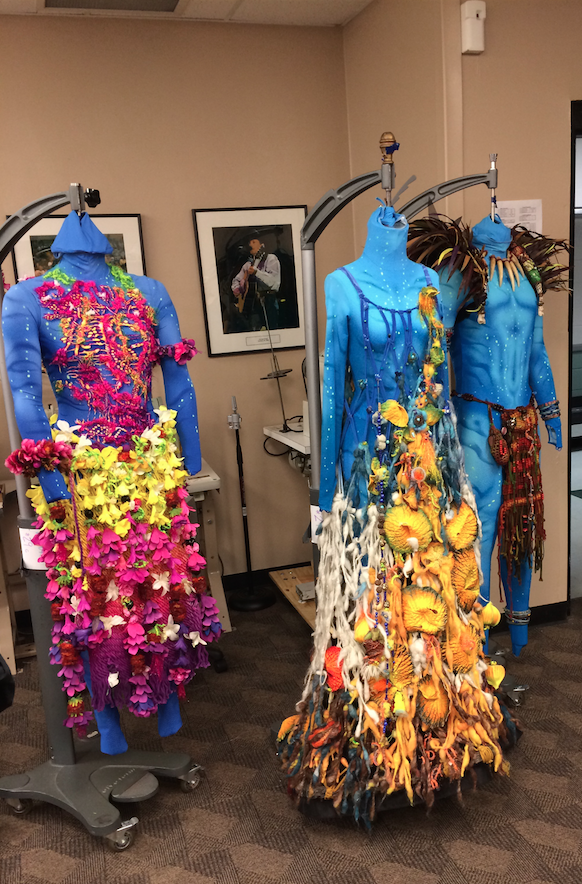
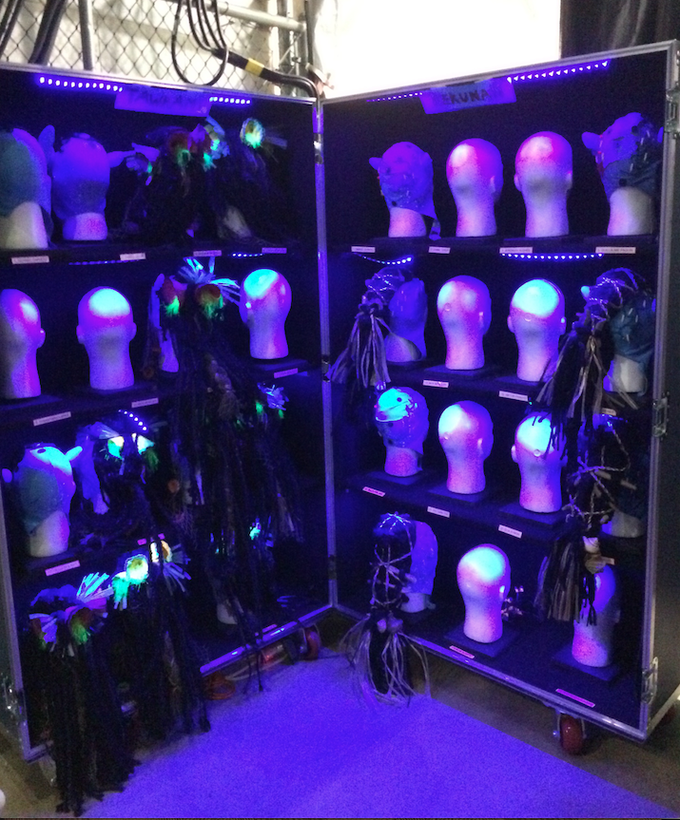
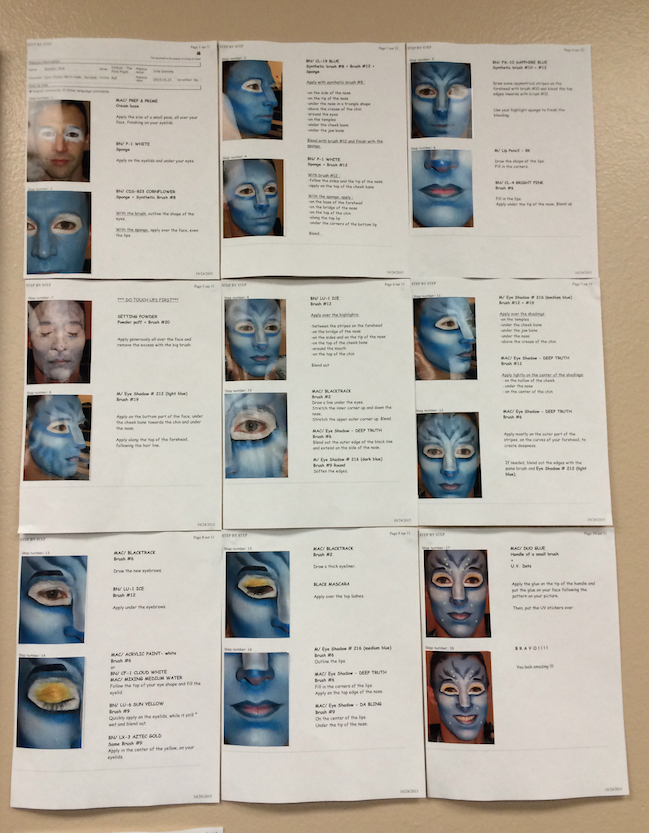
I have never peeked behind the curtain of Cirque du Soleil, and it was one of those weird things where geniuses and top-of-the-line craftsman make it appear that what they’re doing it just business as usual as they’re achieving miracles in front of your very eyes. These guys aren’t pretentious French-speaking douchebags who look down on you for being wowed or impressed by what’s going on; the common thread with all of these departments was that they were all proud, giddy, and excited to show off the work they had done, and to talk about how great the whole experience has been.
Now, this isn’t the kind of thing everyone has access to, whether due to finances, geographical proximity (though they promise to tour internationally for several years), or what have you, but I reckon it’s a must-see for AVATAR fans and worthy of consideration for everyone else. This is a better sell for the upcoming massive expansion of AVATAR lore than the actual film, and I wouldn’t be surprised if it brought new fans over due to the caliber of storytelling, stuntwork, immersion, and artistry on display.
TORUK - THE FIRST FLIGHT will premiere at the CenturyLink in Bossier City, LA on November 12th before beginning it’s tour across the U.S. To buy tickets or see when the show is coming near you, visit here.
